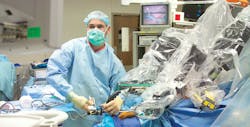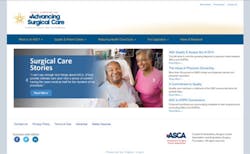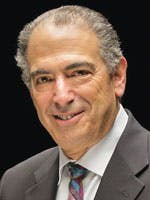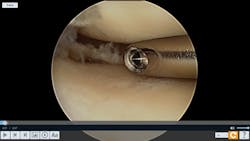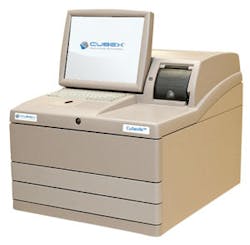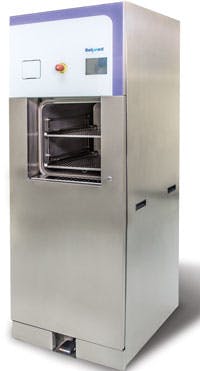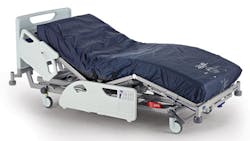Ambulatory surgery centers (ASCs) are surfacing across the country with greater speed than ever before as healthcare providers – and patients – seek ways to cut costs and improve efficiencies.
“The number of outpatient procedures has risen dramatically since 1981, and the majority of surgeries performed in the United States now take place in outpatient settings,” wrote the authors of a study published in Health Affairs.1. Outpatient surgeries cost less at ASCs than they do in hospitals and can save time as well, approximately 32 minutes less per procedure, on average. “[Our] findings suggest that ASCs provide an efficient way to meet future growth in demand for outpatient surgeries and can help fulfill the Affordable Care Act’s goals of reducing costs while improving the quality of health care delivery.”
Winning in the ASC arena means finding ways to implement and execute best practices and standards similar to those practiced by hospitals. Although ASCs are working with fewer assets compared to large medical centers, they can find support from a variety of resources specifically designed to help ASCs succeed.
The Ambulatory Surgery Center Association (ASCA) represents ASCs and provides advocacy and resources to assist ASCs in delivering high-quality, cost-effective ambulatory surgery to its patients. Kay Tucker, Director of Communications, ASCA, said they are dedicated to assisting ASCs to operate efficiently while maintaining a focus on patient safety. Highlighting the similarities between the stringent standards of hospitals and ASCs, she said there should be no question as to whether ASCs are inferior in any way to hospitals – because hospitals and ASCs play by the same rules.
“ASCs are well-recognized for their outstanding patient outcomes, patient safety, customer service, and staff and cost efficiencies,” Tucker said. “ASCs are highly regulated and subject to extensive oversight, just like hospitals. Medicare-certified hospital outpatient departments must comply with Centers for Medicare and Medicaid Services’ (CMS) Conditions of Participation, while Medicare-certified ASCs must comply with CMS’s Conditions for Coverage. Both include rigorous requirements regarding patient safety, governance, operational policies and procedures, and more.
“ASCs follow the same nationally and internationally recognized infection-prevention guidelines as hospitals,” continued Tucker. “As one small example, Medicare quality-reporting data released recently shows that more than 99 percent of Medicare-certified ASCs use a safe-surgery checklist. All Medicare-certified ASCs are required to comply with infection-
prevention requirements specified in Medicare’s Conditions for Coverage and the Interpretive Guidelines for ASCs.” Visit ASCA’s web site at http://www.ascassociation.org/asca/federalregulations/medicarecertification.
Accreditation
An important step in establishing credibility is for ASCs to seek accreditation and remain committed to always following those standards. “ASCs seek accreditation for many reasons, including demonstrating the high quality of care they provide, to qualify for Medicare-deemed status, and, in some cases, to meet state licensing requirements,” Tucker noted. “ASCs routinely tell us that the best way to prepare for an accreditation survey is to live according to the standards at all times.”
The American Association for Accreditation of Ambulatory Surgery Facilities (AAAASF) is another organization ASCs look to for keeping the bar high on patient care in the outpatient setting. Gary Brownstein, MD, Vice President of Education, talked about the organization’s purpose and AAAASF’s goals for ASCs, both of which center on creating a safer patient environment and experience. “The mission of AAAASF is patient safety,” said Brownstein. “Our accreditation programs help facilities demonstrate a strong commitment to patient safety, standardize quality, promote services to patients, and collaborate with other healthcare leaders.”
Brownstein said AAAASF requires that ASCs hold office-based surgery settings to hospital standards with board-certified surgeons who have hospital privileges for any procedure performed and employ anesthesia professionals for deeper levels of anesthesia. ASCs must also provide a safe surgical environment, equipment, drugs, etc., through specific standards regarding hand hygiene, asepsis, sterilization, and sterile supplies, etc., and must implement peer review (peer oversight) and tracking of data (complications, mortalities, etc.).
“At AAAASF, we believe there should not be a gap between acute versus non-acute facilities,” asserted Brownstein.
Technology aids compliance
Ensuring ASCs are in compliance with accreditation organizations’ standards is no small task. To help keep its ASCs efficient and compliant with accreditation organizations’ standards, Mercy, a health system in Missouri with 700 physician practices and outpatient facilities, uses advanced analytics technology. Betty Jo Rocchio, CRNA, MS, Vice President of Perioperative Performance Acceleration at Mercy, explained that making an abundance of easy-to-access data available to caregivers supports efforts to follow best practices at all times.
“Mercy’s analytics program, powered by SAP, provides a custom perioperative dashboard that enables monitoring and tracking of all surgical implants across Mercy’s seven ASCs in four states,” said Rocchio. “This includes visualization of implant use for clear insight delivered the next day and granular detail into regulatory- and compliance-related information. For example, the dashboard shows all the details related to implants and allows them to be tracked to specific patient data in our electronic health record. All of this information is readily available for extract and reporting for any regulatory or compliance organization or for when there is a national recall. With Mercy’s dashboards, we can quickly and dynamically group and filter based on criteria such as physician and procedure type for leaders to easily identify variance and determine standards in supplies based on the best cost and outcome.
“Mercy uses the dashboard to identify best practices through a transparent approach that creates visibility into outcomes and cost per case across Mercy’s regions, locations, and physicians, down to the implant used,” continued Rocchio. “Tracking this information through the dashboard helps Mercy ensure the right patient has the right procedure using the right implant for the best outcome.”
Rocchio also related that Mercy’s system elevates the level of patient care while considering financial constraints, which is especially helpful given that ASCs tend to operate on limited budgets and a smaller staff. “Mercy’s perioperative analytics platform provides leaders insight into our own operations, while enabling us to compare Mercy’s ASCs to other like-size surgery centers to find benchmarks and best practices. Additionally, ASCs often have working managers who are spending time with the patient, not leaving time to scour data and reports. These managers benefit from the dashboard’s automation and instant insight.”
The system’s cost and outcomes analysis feature is also a valuable tool that helps to identify which surgical products are the most cost-effective and deliver the best clinical outcomes for Mercy’s surgical patients while eliminating those deemed unsuitable or less effective. “We were able to reduce the use of the ultrasonic devices, a surgical technology used to minimize intraoperative blood loss,” said Rocchio. “Where there was no clinical evidence of its benefit, Mercy was able to steward resources and pass on cost savings to surgical patients.”
Tracking surgical activities with imaging technology is another way for ASCs to adhere to best practices. Eddie Mitchell, CEO, Image Stream Medical, said some facilities are using the company’s technology to improve clinical collaboration through the sharing of surgical video and pictures. “For example, AAAASF requires ASC commitment to quality assessment and improvement,” Mitchell said. “Recording surgical imagery and clinician activities during a case allows ASCs to highlight examples of clinicians performing best practices and modeling ways of communicating that improve teamwork and outcomes. Image Stream content management capabilities give ASCs secure access to this information for all kinds of quality improvement, staff review, onboarding, research, and educational purposes.”
To underscore how patient safety is just as important in an ASC as it is in the acute-care environment, Mitchell drew a parallel line between acute-care versus non-acute care and inpatient versus outpatient activities, explaining how Image Stream technology supports compliance with best practices. “AAAASF requires a ‘surgical-pause’ or ‘time-out’ protocol be conducted prior to each procedure to avoid wrong-surgery and wrong-site errors. Image Stream builds a time-out function right into the room’s preoperative workflow, so that it’s not missed. The time-out function automatically brings the ASC’s specific pause protocol up on all displays in the room, and it adjusts the lights and music so that everyone can pay attention during this important step in a procedure.”
Mitchell explained further why their product is particularly appropriate for ASCs. “Image Stream provides highly modular, procedure-space integration solutions that include room control, surgical video recording, image capture, collaboration, and content-management functions. These visual collaboration tools support more efficient clinician workflows; for example, streamlining patient registration and case-close processes, which make them well-suited to a high-volume ASC. Since many ASC clinicians also will practice at associated full-service hospitals, it’s important to be able to access patient surgical video and image data wherever they are. Image Stream’s content-management system supports this kind of ‘anywhere’ access easily and securely across an enterprise. In addition, Image Stream supports the kind of cost-effective scalability needed in the market, scaling easily from a couple of rooms in a single ASC to hundreds of suites for a nationwide organization.”
Henry Schein Medical is another resource that assists with compliance requirements by offering a variety of products and services that target the unique needs of the ASC. “We actively monitor ASCA discussion boards to ensure our products and solutions address unmet needs,” said Scott Jackson, Healthcare Services General Manager, ASCs. “One such solution is an application that streamlines and automates ASC facility compliance. This application allows an ASC to more efficiently manage ongoing compliance requirements.”
Other ASC-specific solutions include revenue-cycle management, electronic medical record, practice marketing, controlled-substance medication-management systems, inventory management, and medical-waste disposal. “Each of these solutions are tailored specifically to meet the needs of an ASC,” declared Jackson. For example, Henry Schein Medical’s network of ASC solutions also make it easier for ASCs to implement best practices for managing medication. “Henry Schein’s medication-management system offers ASCs the ability to manage controlled substances within their center more effectively, leading to better control and controlled-substance recordkeeping, ultimately reducing the chances for diversion. We recently placed three such systems in a three–operating-room multispecialty ASC that had experienced issues with diversion in the past. Our system greatly reduced this center’s probability for future diversion issues, due to the enhanced controls now in place.”
ASCs that are looking to gain greater control over their medical-products inventory can also find support. “Our multi-vendor ASC materials-management system allows ASCs the ability to reduce days on hand of product, automates the physical-inventory count process, and enhances the ASC’s ability to manage preference cards and perform case costing in a more accurate manner. Henry Schein Medical also offers ASCs the ability to place low unit-of-measure orders late in the day and receive them the next day, which helps to facilitate just-in-time inventory management.”
Clean and compliant
ASCs also strive to hold the bar up high when it comes to sterile-processing activities and aim to follow the same standards and best practices as do hospitals – and oftentimes with much less.
“The ASC has the same reprocessing requirements and cost constraints as a sterile-processing department in an acute-care hospital,” said Joe Smith, Director of Marketing, Belimed Inc. “The primary difference is the ASC has tighter space requirements, lower instrument volumes, and quicker turnaround times.”
To comfortably fit the space constraints common to ASCs, Belimed’s MST V 446 sterilizer, new Belimed Protect cleaning solutions, and WD 200 washer/disinfector are part of a comprehensive portfolio of products for the ASC’s sterile-processing area. “Each of these products offers a smaller footprint and chamber capacity, making them more suitable to the lower volumes of an ASC,” Smith said. “To meet the quicker turnaround requirements, the WD 200 cycles have been optimized for minimum time, when used in combination with the Belimed Protect detergent.”
John Nies, Product Manager, Belimed Inc., and an AAMI ST79 Committee Member, dispelled rumors that ASCs are not subject to AAMI’s recommended practice for hospital steam sterilization. “I have heard stories that some ASCs believe that AAMI ST79, the standard for best practices in sterile processing, may not be applicable to them, as they are different from acute-care facilities; nothing could be further from reality,” Nies affirmed. “The Joint Commission uses ST79 as a guidance document for their surveys. As they visit more and more ASCs, noting practices that do not follow ST79 standards, that reality is being recognized. Every facility, including ASCs, that reprocesses instruments, should own and follow ST79.”
Nies strongly recommends taking advantage of education provided at related organization meetings, to keep best practices strong and updated. “Attending IAHCSMM conferences and networking with colleagues from other facilities, both local and national, is a great way to keep in touch with current best practices and can help make The Joint Commission visit go smoother. Of course, the most important end result is a better process, which keeps the patient safer.”
Sore-spot solutions
As the patient population ages and ASCs become more ubiquitous – and busy – the risk of patients developing pressure ulcers is another important consideration. Even shorter procedures can put certain patients at risk. Pressure ulcers are costly, too.
Debra Meixsell, Wound Care and Bariatric, TSS Marketing, Getinge Group, Americas, said the RIK Fluid Overlay with Skin IQ Microclimate coverlet offers a safer environment for their patients who may be at risk of developing pressure ulcers. “The RIK products both contain a viscous fluid that conforms to ‘micro’ contours of the body to relieve pressure and ‘flow’ with patient movement to help prevent friction and shear,” explained Meixsell. “It’s like lying in pudding, where the fluid envelops the patient, protecting them from the operating room table, and then as they move into the recovery room. The Skin IQ is a microclimate coverlet that fits right over the RIK Overlay and draws moisture away from the patient’s skin using negative-airflow technology. Simply put, it’s a mighty coverlet, pulling moisture away from the patient at a higher level than traditional low air-loss products, which are blowing up and around the
patient.”
Reference
1. Munnich EL, Parente ST. Procedures take less time at ambulatory surgery centers, keeping costs down and ability to meet demand up. Health Affairs (Millwood). 2014;33(5):764-769.
About the Author

Susan Cantrell
Susan Cantrell is Infection Prevention Editor for Healthcare Purchasing News.
